Less Brand, More Identity: The Zombie Business Cure
- Fahad H

- Dec 7, 2017
- 6 min read
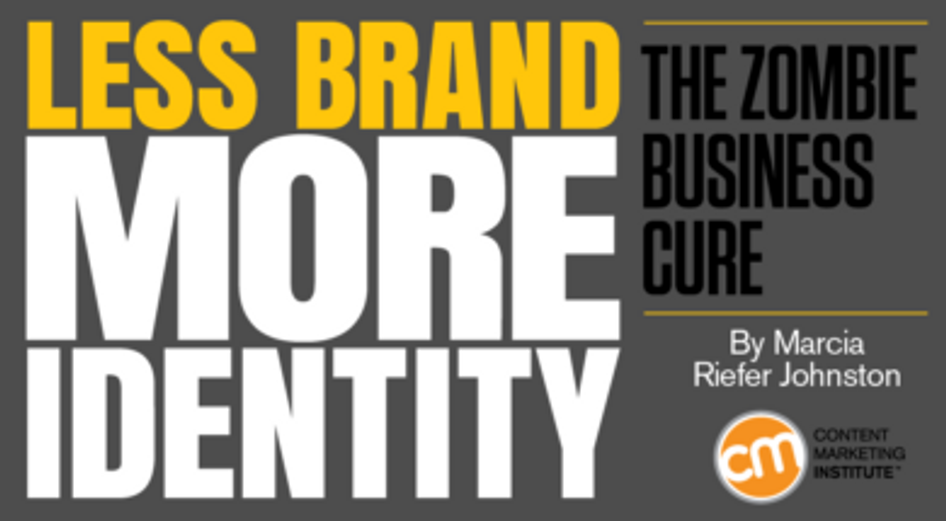
No company wants to be a zombie – an uncaring, brainless, ruthless, inhuman thing that does whatever it takes to keep going. Yet examples abound of companies that behave in zombie-like ways, often paying the price in lost sales and damaged reputations.
How does a business cure itself of a case of the zombies? That’s the question that content strategist and UX specialist Melissa Eggleston answers in her Content Marketing World talk, Zombies All Look the Same: Using Identity-based Content Strategy to Stand Out.
The author of the book The Zombie Business Cure: How to Refocus Your Company’s Identity for More Authentic Communication, Melissa urges businesses to concern themselves less with their brands (how they want to be seen) and more with their identities (who they are). Businesses should concern themselves less with their brands & more with their identities. @melissa_egg Click To Tweet
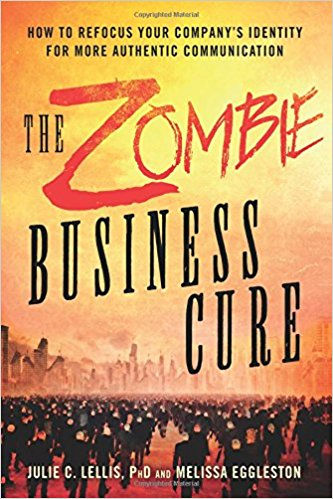
This article peeks into Melissa’s messages for marketers. (All images come from her presentation slides.)
HANDPICKED RELATED CONTENT: Identity Matters: How Content Strategists Build Trust and Loyalty
Discover and celebrate your company’s unique identity
Zombies lack distinctive identities. They look, sound, and act the same. Melissa describes them as indistinguishably reckless, haphazard, stiff, and self-absorbed – the last thing we want our companies to be.Zombies are reckless, stiff, & self-absorbed – the last thing we want our companies to be. @melissa_egg Click To Tweet
Too many companies look the same. For example, “we’re helpful” is not a distinctive identity, Melissa says. Any company could be helpful.
Each company must have a distinctive identity that make its products, services, and employees unmistakably its own. Even if your products or services are similar to your competitors’, you must discover and celebrate what makes you unique.You must discover and celebrate what makes your company unique, says @melissa_egg. Click To Tweet
Your company might even be radically unique. For example, Melissa points to Brian Kidd, the Unipiper of Portland, Oregon. Brian found some bagpipes in a trash bin “and rolled with it.” He created a persona for himself that’s “quirky and weird.” He celebrates standing out. People get excited about Unipiper sightings.
The Unipiper is the opposite of a zombie. Discover and celebrate your company’s inner Unipiper.
One organization whose unique identity pops to mind is Merriam-Webster, which has been making headlines for posting tweets that are, as one blogger puts it, “topical, funny, smart, and informative while also being relentlessly irreverent.”
Have a great #MemorialDayWeekend. The hot dog is a sandwich. https://t.co/KeNiTAxPAm — Merriam-Webster (@MerriamWebster) May 27, 2016
I refer to the dictionary publisher’s “identity” here instead of its “brand” because, if I believe its staff, “it’s not a marketing construct, it’s who we really are.” That distinction between a company’s constructed brand and its identity is exactly what Melissa digs into.
HANDPICKED RELATED CONTENT:
Align your brand with your identity
Every company has an identity: who it is as reflected in the corporate culture. Ideally, the brand – who the company tells the world it is – aligns with its identity.
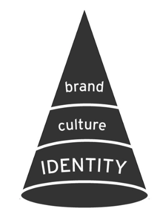
If all brands were aligned with their companies’ identities, Melissa would have had little to say in her talk and nothing to write a book about. But the world is full of stories about corporations claiming to be one thing and proving to be another. Melissa illustrates this kind of “problematic brand” as a cone with its top chopped off.
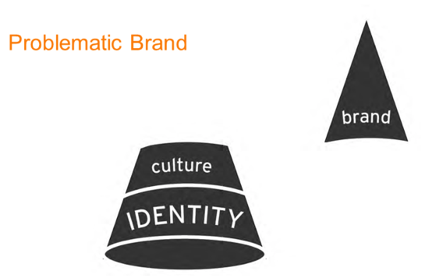
A zombie-like (haphazard, self-absorbed) company that pretends to be otherwise has a problematic brand.Is your org a zombie? Make sure that brand and identity align, says @melissa_egg. Click To Tweet
Melissa gives plenty of examples of problematic brands, including the 2009 story of the self-proclaimed “friendly skies” airline, United, refusing to replace a passenger’s guitar damaged by its employees. (As of this writing, the guitar owner’s music video, United Breaks Guitars, has had over 17.6 million views.) The airline’s recent violent eviction of a passenger from his seat – an incident that cost the company some $255 million in market value – only made the discrepancy between the company’s brand and its identity more glaring.
Align your content with your identity
To avoid being a zombie, your company must develop its identity around core values that show up consistently in what employees do, how they look, and what they say – including all the content they create.
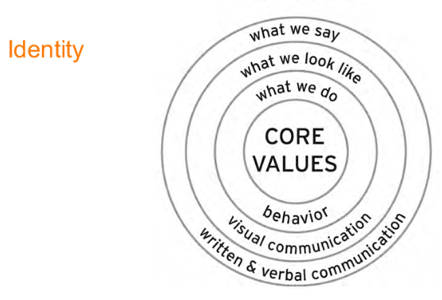
“The identity circle shows how we believe effective organizations grow from the core,” Melissa says. When a unique identity is clear and distinct, “an organization attracts audiences that share its core values,” she explains.Brands with unique identities attract audiences that share their core values. @melissa_egg Click To Tweet
Keeping everyone aligned on core values “is a full-time job in a large company,” Melissa says, quoting Charles Schwab CMO Jonathan Craig. “Be remarkably consistent; be remarkably repetitive, so that everyone has a clear sense of who you are, what you stand for, and what you do.”Be consistent & repetitive so it's clear who you are, what you stand for, & what you do. @JonathanCraig Click To Tweet
If you’re a parent, you understand this need to repeat core values. As a mom, Melissa repeats herself a lot, saying, “We don’t hit people” or “We are kind in our family.” Similarly, businesses must state their core values over and over.
Your company may document its core values in various ways – a vision statement, a mission statement, a purpose statement, a statement of values. However these values are communicated, they must inspire people and they must indicate how you differ from the competition.
A strong identity starts with core values and ends with authentic communication. Melissa says, “Keep your core values in the forefront when creating content: website copy, videos, brochures, social media posts, taglines, promotions – all content.”
If your company hasn’t articulated its core values, Melissa suggests asking your leaders what three adjectives they would want others to use to describe your organization. She calls this a “quick-and-dirty messaging solution.” You can then use the three descriptive words as your guideposts whenever you create or edit content.
HANDPICKED RELATED CONTENT:
An exemplary un-zombie-like company
Melissa could talk your ear off about the 42-year-old financial services company Charles Schwab. The company’s customer-centric identity (expressed in its motto “through clients’ eyes”) shows up throughout the company, including in its approach to content. Melissa explains how that happens and manifests itself:
Each year, when it’s time to update the strategic communications plan, Schwab’s communications team reviews not only business priorities but also customer feedback.
Schwab ensures that its priorities translate to the customer. For example, “emphasizes transparency in communication,” means “customers understand all fees.”
The company provides free workshops with financial experts both in person and online, publishes how-to videos and articles on its website, and mails its customers a magazine filled with education on financial topics.
All 16,000 employees participate in workshops to discuss how they personally define Schwab’s values and how they might explain Schwab to outsiders. These workshops help employees keep their messages aligned and accurate while supporting them in feeling proud of what they have to say. (When you don’t feel proud of your employer, says CMO Craig, “that’s when you look for another job.”)
Schwab “doesn’t emphasize its products and services in marketing.” For example, its Own Your Tomorrow campaign focuses on potential customers and their dreams, futures, and values.
Throughout the year, user-experience research offers new insights and informs changes to Schwab’s websites and software.

In other words, Schwab has put its brand squarely in line with its identity, which grows out of core values that are widely reinforced. Schwab employees do everything – including plan, create, and maintain their content – based on those core values..@CharlesSchwab employees plan, create & maintain content based on company’s core values. @melissa_egg Click To Tweet
Schwab’s distinctly un-zombie-like way of doing business has resulted in “ridiculous” success, Melissa says.
HANDPICKED RELATED CONTENT: How Financial Services Companies Build Relationships Through Content
Conclusion
Is your company’s identity unique? Is its brand aligned with that identity? How about the content across the organization – is that aligned too? If you answer no to any of these questions, your organization might be a zombie.
Try Melissa’s cure: Get your colleagues to think less about your brand and more about your collective identity. Reviving your company’s humanity may be the best thing you can do for your content and for the bottom line.
Here’s an excerpt from Melissa’s talk:
Learn more about how to use a customer-first content strategy approach to better your brand’s marketing and much more at the Intelligent Content Conference March 20-22 in Las Vegas. Register today.
Cover image by Joseph Kalinowski/Content Marketing Institute








Comments